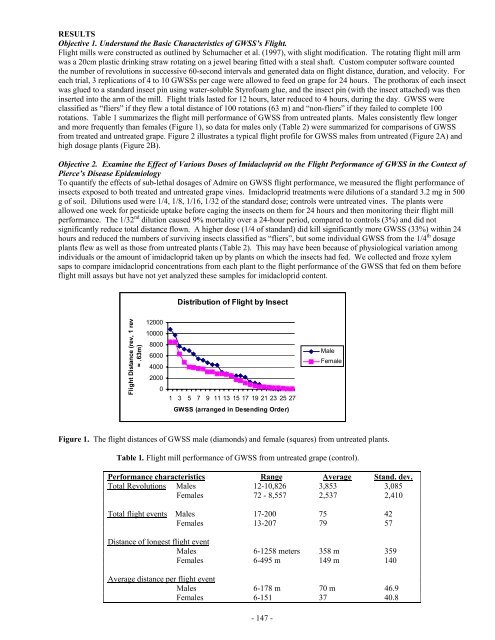Impact Of Host Plant Xylem Fluid On Xylella Fastidiosa Multiplication ...
Impact Of Host Plant Xylem Fluid On Xylella Fastidiosa Multiplication ...
Impact Of Host Plant Xylem Fluid On Xylella Fastidiosa Multiplication ...
Create successful ePaper yourself
Turn your PDF publications into a flip-book with our unique Google optimized e-Paper software.
RESULTS<br />
Objective 1. Understand the Basic Characteristics of GWSS’s Flight.<br />
Flight mills were constructed as outlined by Schumacher et al. (1997), with slight modification. The rotating flight mill arm<br />
was a 20cm plastic drinking straw rotating on a jewel bearing fitted with a steal shaft. Custom computer software counted<br />
the number of revolutions in successive 60-second intervals and generated data on flight distance, duration, and velocity. For<br />
each trial, 3 replications of 4 to 10 GWSSs per cage were allowed to feed on grape for 24 hours. The prothorax of each insect<br />
was glued to a standard insect pin using water-soluble Styrofoam glue, and the insect pin (with the insect attached) was then<br />
inserted into the arm of the mill. Flight trials lasted for 12 hours, later reduced to 4 hours, during the day. GWSS were<br />
classified as “fliers” if they flew a total distance of 100 rotations (63 m) and “non-fliers” if they failed to complete 100<br />
rotations. Table 1 summarizes the flight mill performance of GWSS from untreated plants. Males consistently flew longer<br />
and more frequently than females (Figure 1), so data for males only (Table 2) were summarized for comparisons of GWSS<br />
from treated and untreated grape. Figure 2 illustrates a typical flight profile for GWSS males from untreated (Figure 2A) and<br />
high dosage plants (Figure 2B).<br />
Objective 2. Examine the Effect of Various Doses of Imidacloprid on the Flight Performance of GWSS in the Context of<br />
Pierce’s Disease Epidemiology<br />
To quantify the effects of sub-lethal dosages of Admire on GWSS flight performance, we measured the flight performance of<br />
insects exposed to both treated and untreated grape vines. Imidacloprid treatments were dilutions of a standard 3.2 mg in 500<br />
g of soil. Dilutions used were 1/4, 1/8, 1/16, 1/32 of the standard dose; controls were untreated vines. The plants were<br />
allowed one week for pesticide uptake before caging the insects on them for 24 hours and then monitoring their flight mill<br />
performance. The 1/32 nd dilution caused 9% mortality over a 24-hour period, compared to controls (3%) and did not<br />
significantly reduce total distance flown. A higher dose (1/4 of standard) did kill significantly more GWSS (33%) within 24<br />
hours and reduced the numbers of surviving insects classified as “fliers”, but some individual GWSS from the 1/4 th dosage<br />
plants flew as well as those from untreated plants (Table 2). This may have been because of physiological variation among<br />
individuals or the amount of imidacloprid taken up by plants on which the insects had fed. We collected and froze xylem<br />
saps to compare imidacloprid concentrations from each plant to the flight performance of the GWSS that fed on them before<br />
flight mill assays but have not yet analyzed these samples for imidacloprid content.<br />
Distribution of Flight by Insect<br />
Flight Distance (rev, 1 rev<br />
= .63m)<br />
12000<br />
10000<br />
8000<br />
6000<br />
4000<br />
2000<br />
0<br />
1 3 5 7 9 111315171921232527<br />
GWSS (arranged in Desending Order)<br />
Male<br />
Female<br />
Figure 1. The flight distances of GWSS male (diamonds) and female (squares) from untreated plants.<br />
Table 1. Flight mill performance of GWSS from untreated grape (control).<br />
Performance characteristics Range Average Stand. dev.<br />
Total Revolutions Males 12-10,826 3,853 3,085<br />
Females 72 - 8,557 2,537 2,410<br />
Total flight events Males 17-200 75 42<br />
Females 13-207 79 57<br />
Distance of longest flight event<br />
Males 6-1258 meters 358 m 359<br />
Females 6-495 m 149 m 140<br />
Average distance per flight event<br />
Males 6-178 m 70 m 46.9<br />
Females 6-151 37 40.8<br />
- 147 -











